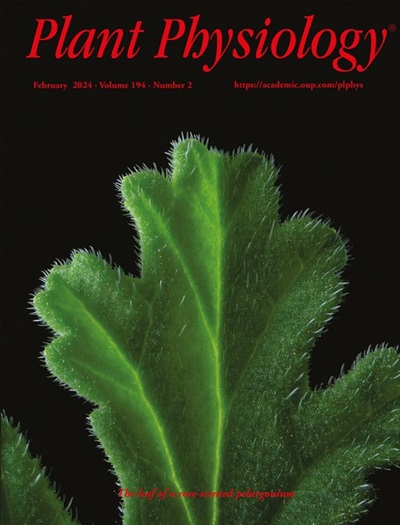SlBIN2 激酶对转录因子 SlBIML1 的磷酸化会延迟番茄开花
IF 6.5
1区 生物学
Q1 PLANT SCIENCES
引用次数: 0
摘要
众所周知,芸苔素甾类化合物(BRs)在植物生长和发育的调控中发挥着重要作用。缺乏芸苔素固醇信号传导的植物会出现植物发育迟缓和开花晚的表型。然而,这一过程所涉及的确切机制还需要研究。在这项研究中,我们克隆了番茄(Solanum lycopersicum)中类似 GSK3 蛋白激酶的 BRASSINOSTEROID INSENSITIVE 2(SlBIN2)的同源物。我们对转基因品系的生长相关过程和表型变化进行了鉴定,发现 SlBIN2s 转基因品系具有发育延迟和生长缓慢的表型。SlBIN2s 在番茄中冗余地负向调控 BR 信号转导。此外,还发现转录因子 SlBIN2.1-INTERACTING MYB-LIKE 1(SlBIML1)是 SlBIN2s 的下游底物,SlBIN2s 与之相互作用并使之磷酸化,从而协同调控番茄的发育过程。具体来说,SlBIN2s 通过磷酸化多个氨基酸残基(包括 Thr266 和 Thr280 位点)来调节 SlBIML1 蛋白的稳定性。这项研究揭示了BR信号通路的一个分支,它能调节番茄的无性生长期并延迟花期转换,而不会对BR信号传导产生反馈影响。这些信息丰富了我们对BR信号下游传导途径的了解,并为调整番茄花期提供了潜在靶标。本文章由计算机程序翻译,如有差异,请以英文原文为准。
Phosphorylation of the transcription factor SlBIML1 by SlBIN2 kinases delays flowering in tomato
Brassinosteroids (BRs) are well known for their important role in the regulation of plant growth and development. Plants with deficiency in BR signaling show delayed plant development and exhibit late flowering phenotypes. However, the precise mechanisms involved in this process require investigation. In this study, we cloned homologs of BRASSINOSTEROID INSENSITIVE 2 (SlBIN2), the GSK3-like protein kinase in tomato (Solanum lycopersicum). We characterized growth-related processes and phenotypic changes in the transgenic lines and found that SlBIN2s transgenic lines have delayed development and slow growing phenotypes. SlBIN2s work redundantly to negatively regulate BR signaling in tomato. Furthermore, the transcription factor SlBIN2.1-INTERACTING MYB-LIKE 1 (SlBIML1) was identified as a downstream substrate of SlBIN2s that SlBIN2s interact with and phosphorylate to synergistically regulate tomato developmental processes. Specifically, SlBIN2s modulated protein stability of SlBIML1 by phosphorylating multiple amino acid residues, including the sites Thr266 and Thr280. This study reveals a branch of the BR signaling pathway that regulates the vegetative growth phase and delays floral transition in tomato without the feedback affecting BR signaling. This information enriches our understanding of the downstream transduction pathway of BR signaling and provides potential targets for adjusting tomato flowering time.
求助全文
通过发布文献求助,成功后即可免费获取论文全文。
去求助
来源期刊

Plant Physiology
生物-植物科学
CiteScore
12.20
自引率
5.40%
发文量
535
审稿时长
2.3 months
期刊介绍:
Plant Physiology® is a distinguished and highly respected journal with a rich history dating back to its establishment in 1926. It stands as a leading international publication in the field of plant biology, covering a comprehensive range of topics from the molecular and structural aspects of plant life to systems biology and ecophysiology. Recognized as the most highly cited journal in plant sciences, Plant Physiology® is a testament to its commitment to excellence and the dissemination of groundbreaking research.
As the official publication of the American Society of Plant Biologists, Plant Physiology® upholds rigorous peer-review standards, ensuring that the scientific community receives the highest quality research. The journal releases 12 issues annually, providing a steady stream of new findings and insights to its readership.
 求助内容:
求助内容: 应助结果提醒方式:
应助结果提醒方式:


